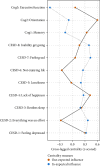Depressive Symptoms and Cognitive Function in Older Adults: A Cross-Lagged Network Analysis
- PMID: 40226749
- PMCID: PMC11919221
- DOI: 10.1155/2024/6166775
Depressive Symptoms and Cognitive Function in Older Adults: A Cross-Lagged Network Analysis
Abstract
Background: Depressive symptoms commonly co-occur with cognitive decline in older adults. However, prospective interrelationships between different cognitive function domains and depressive symptoms are not well understood. This study evaluated prospective interrelationships between depressive symptoms and cognitive functioning components among individuals aged 50 years or older from a perspective of network analysis. Method: Longitudinal data from the English Longitudinal Study of Aging were analyzed. Depressive symptoms were measured with the eight-item Center for Epidemiologic Studies Short-Depression Scale. Cognitive functions assessed included memory, orientation, and executive function. Contemporaneous network analyses were conducted using mixed graphical model, while a temporal network model was assessed using cross-lagged panel network model. To identify important predictors and outcomes, centrality indices, including expected influence, out-expected influence, and in-expected influence, were calculated. Results: A total of 6,433 older adults were included in the network analysis. Baseline "Not enjoy life" (CESD-6) was negatively associated with executive function at the follow-up assessment. Moreover, improvements in "Everything was an effort" (CESD-2) and "Loneliness" (CESD-5) were related to less future decline of executive function and memory ability. Furthermore, analyses suggested targeting "Lack of happiness" (CESD-4) could be useful in reducing the co-occurrence of depression and cognitive decline among older adults. Conclusions: This network analysis study highlighted dynamic interrelationships between depressive symptoms and cognitive decline in older adults. Findings suggest that interventions targeting specific depressive symptoms may have the potential to alleviate declines in executive function and memory for this population.
Keywords: cognitive decline; cross-lagged network analysis; depression; executive function.
Copyright © 2024 He-Li Sun et al.
Conflict of interest statement
The authors declare no conflicts of interest.
Figures



Similar articles
-
A longitudinal study of the mediator role of physical activity in the bidirectional relationships of cognitive function and specific dimensions of depressive symptoms.J Affect Disord. 2024 Dec 1;366:146-152. doi: 10.1016/j.jad.2024.08.175. Epub 2024 Aug 28. J Affect Disord. 2024. PMID: 39209276
-
A network analysis of depressive symptoms and cognitive performance in older adults with multimorbidity: A nationwide population-based study.J Affect Disord. 2025 Aug 15;383:78-86. doi: 10.1016/j.jad.2025.04.122. Epub 2025 Apr 22. J Affect Disord. 2025. PMID: 40274116
-
Prospective associations between depressive symptoms and cognitive functions in middle-aged and elderly Chinese adults.J Affect Disord. 2020 Feb 15;263:692-697. doi: 10.1016/j.jad.2019.11.048. Epub 2019 Nov 11. J Affect Disord. 2020. PMID: 31744738
-
Persistent depressive symptoms and cognitive decline in older adults.Br J Psychiatry. 2018 Nov;213(5):638-644. doi: 10.1192/bjp.2018.155. Epub 2018 Aug 22. Br J Psychiatry. 2018. PMID: 30132434
-
Affective problems and decline in cognitive state in older adults: a systematic review and meta-analysis.Psychol Med. 2019 Feb;49(3):353-365. doi: 10.1017/S0033291718001137. Epub 2018 May 24. Psychol Med. 2019. PMID: 29792244 Free PMC article.
Cited by
-
The relationship between frailty in older adults and anxiety and depression in china: propensity score matching and network analysis.Front Psychiatry. 2025 Jul 30;16:1596015. doi: 10.3389/fpsyt.2025.1596015. eCollection 2025. Front Psychiatry. 2025. PMID: 40809861 Free PMC article.
-
Gender differences in like-sex middle-aged twins: an extended network analysis of depressive symptoms, cognitive functions and leisure activities.Eur Psychiatry. 2025 Mar 12;68(1):e46. doi: 10.1192/j.eurpsy.2025.31. Eur Psychiatry. 2025. PMID: 40070344 Free PMC article.
-
Core Symptoms and Dynamic Interactions of Depressive Symptoms in Older Chinese Adults: A Longitudinal Network Analysis.Depress Anxiety. 2025 Jul 23;2025:8078557. doi: 10.1155/da/8078557. eCollection 2025. Depress Anxiety. 2025. PMID: 40740343 Free PMC article.
-
The relationship between neurofilament light chain and depressive symptoms according to cognitive status.Alzheimers Dement (N Y). 2025 May 8;11(2):e70048. doi: 10.1002/trc2.70048. eCollection 2025 Apr-Jun. Alzheimers Dement (N Y). 2025. PMID: 40352263 Free PMC article.
References
-
- Bai W., Chen P., Cai H., et al. Worldwide Prevalence of Mild Cognitive Impairment among Community Dwellers Aged 50 years and Older: A Meta-Analysis and Systematic Review of Epidemiology Studies. Age and Ageing . 2022;51(8)afac173 - PubMed
Publication types
MeSH terms
LinkOut - more resources
Full Text Sources
Medical

